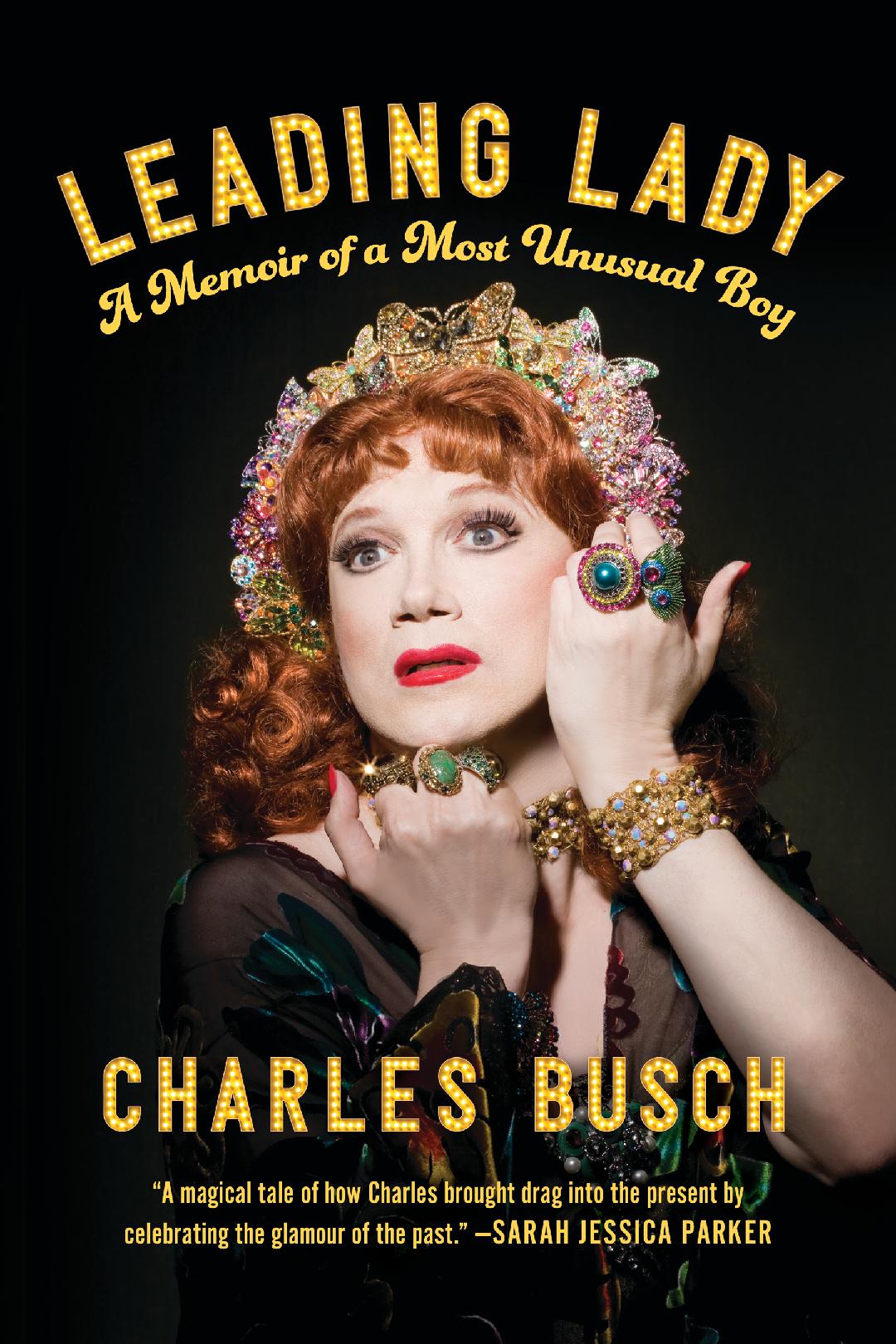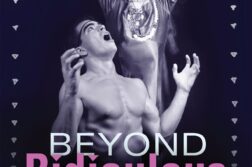LEGENDARY DRAG PERFORMER and playwright Charles Busch lets it all hang out in his candid new memoir Leading Lady: A Memoir of a Most Unusual Boy (Smart Pop Books). It’s an intensive look back at his life encompassing early memories of yearning to be on stage as a boy and success with his own plays (among them The Tale of the Allergist’s Wife and Vampire Lesbians of Sodom) and various celebrity encounters with people ranging from Milton Berle to Audra McDonald.
Having been obsessed with cinema since childhood, Busch often sees his life through the lens of film. At one point, he concedes: “I can’t tell whether my life is unusually jam-packed with classic movie moments or if I simply translate my experiences into cinematic tropes.” Divided into a series of anecdotes about hit plays, bombs, celebrities, and even a bit of sex work, Busch’s writings are inviting and often hilarious. It’s a fascinating ode to a life in show biz and, as the author makes clear, such a career path is not one for the faint of heart.
Busch spoke to me by phone from his New York City apartment. — MH
Matthew Hays: I love the format of this book: it’s a series of fascinating anecdotes. How did you arrive at this format?
Charles Busch: Over the fourteen years I’ve been slaving over this tome, I tried writing it as a linear autobiography beginning with “In 1905, my grandparents arrived on Ellis Island from Russia.” In year eleven, I decided to structure it as a literary collage but with a chronological underpinning. When reading theater memoirs, I get restless waiting for the juicy celebrity encounters. I toss ’em in throughout the book.
MH: Are there any past memoirs that inspired you?
CB: I loved Ruth Gordon’s 1971 memoir Myself Among Others, where she flings the past about like playing cards with seemingly no attempt at structure, just one fabulous tale after another.
MH: You talk about times when you received the occasional negative review. Who are the critics you really care about?
CB: There are so few critics writing today. A vanishing trade. Ben Brantley, the retired chief theater critic of The New York Times, really got me. When he’d give a play of mine a mixed review, I’d be disappointed and at times enraged. Eventually, I’d calm down and see his point of view. On several occasions, I’d implement his suggestions into the published edition of the play.
MH: You certainly capture the ups and downs of a life in show biz. What was the toughest part about writing this memoir?
CB: The chapters on how I got my big break in 1985 with the production of my play Vampire Lesbians of Sodom. I had already written a highly fictionalized 1993 autobiographical novel, Whores of Lost Atlantis, about this period. It was a struggle to remember what really happened and honestly explore my emotions during this crucial time.
MH: What was the most exciting part of the writing process?
CB: It’s been fun looking back and seeing how often over the years I seem to have been accepted as a fellow grande dame of the theater, sharing dressing rooms with the likes of Carol Channing, Audra McDonald, Michele Lee, and Elaine Stritch.
MH: I was very happy to read your frank anecdotes about sex work.
CB: There frankly wasn’t that much sex in sex work. An hour goes very quickly by the time you finish vamping and chatting. Most of my clients were deeply closeted older family men. Suburban grandfathers. In the year that I pursued this profession, I learned not to be so quick in defining who’s gay and who’s straight.
MH: Joan Collins once told me that glamour wasn’t necessarily an inborn trait, and that it could be learned. Do you agree?
CB: I’m not sure if I agree with Dame Joan. You can dress someone up and drape them in haute couture and they just seem like a schlub who fell into a laundry basket of feathers and furs. To have that kind of dazzling radiance requires an innate confidence, a swagger, and also vulnerability. Arrogance lends itself to fake glamour. Marlene Dietrich knew she was glamorous. She didn’t need to be pushy about it.
CB: To compare them is not fair to today’s stars. Contemporary actresses are unprotected. We know too much about them. The classic stars were shrouded in illusion by the studios. They were photographed in gauzy, silvery black-and-white. The movies they appeared in were stylized confections, whether romantic comedy or film noir. Harsh reality and high def don’t lend themselves to mystique. I think we’re starved for that kind of flamboyant lady. The great enthusiasm for Jennifer Coolidge attests to that. Perhaps that’s why the drag queens on RuPaul’s Drag Race have become so popular. They give us the bigger-than-life substance that we used to enjoy in actresses.
MH: You write about hanging out and working with Joan Rivers. She was a very public person who wrote several books and gave extensive interviews, and there was a documentary made about her. Is there something you know about Joan Rivers that the public doesn’t know?
CB: Joan was a great listener and didn’t suck the air out of a room. She made you feel important. You felt safe with her, and secure that if anything bad ever happened, she’d save you. She exhorted me to “Say yes to everything!” I took her advice, but later told her: “Joan, I did what you said and bitterly regret it.”
MH: Many are nostalgic for the Manhattan of the ’70s, when crime was rampant but artists could afford rent. What’s your sense of where the city is headed now, post-pandemic?
CB: I try to be optimistic. Negativity and bitching that everything used to be better isn’t terribly attractive in an older person. Even if I think it, I won’t say it. The outdoor eating areas have given otherwise dreary city blocks a certain raffish bohemian charm. There’s a lot of youthful artistic creativity on the Internet, and it’s great that it can be shared with everyone via social media. Am I fooling you?
MH: Are there drag artists today who you think are doing inspiring work?
CB: Many. Sasha Velour is such an enigmatic mix of beauty and skill. Jinkx Monsoon is very much in my direct theatrical line. It’s thrilling seeing her talents moving her on to Broadway stages and television. I’m a tad jealous of her opportunities in this new day and age. But ultimately, it’s difficult to be resentful when that person is so gifted and deserving.
MH: You had heart surgery a few months ago. Has that changed your perspective on life?
CB: I don’t think I’ve ever gleaned any wisdom from my experiences. My saving grace is turning them into narrative while they’re happening. Writing this book has forced me to explore the motivations of the various people I’ve encountered and be far more forgiving.
MH: An awful question, but it has to be asked: what do you make of the current war on drag?
CB: It’s terrifying. This war on drag is part of the conservative obsession with trans people and ultimately with gay and lesbian people. The final straw was blurring the line between the genders. Being male or female was the one thing for the conservatives that couldn’t be disputed. I’m proud to be an American and proud to be a drag performer, unruly and untucked.
Matthew Hays is co-editor (with Tom Waugh) of the Queer Film Classics series and teaches media studies at Marianopolis College and Concordia Univ. in Montréal.






